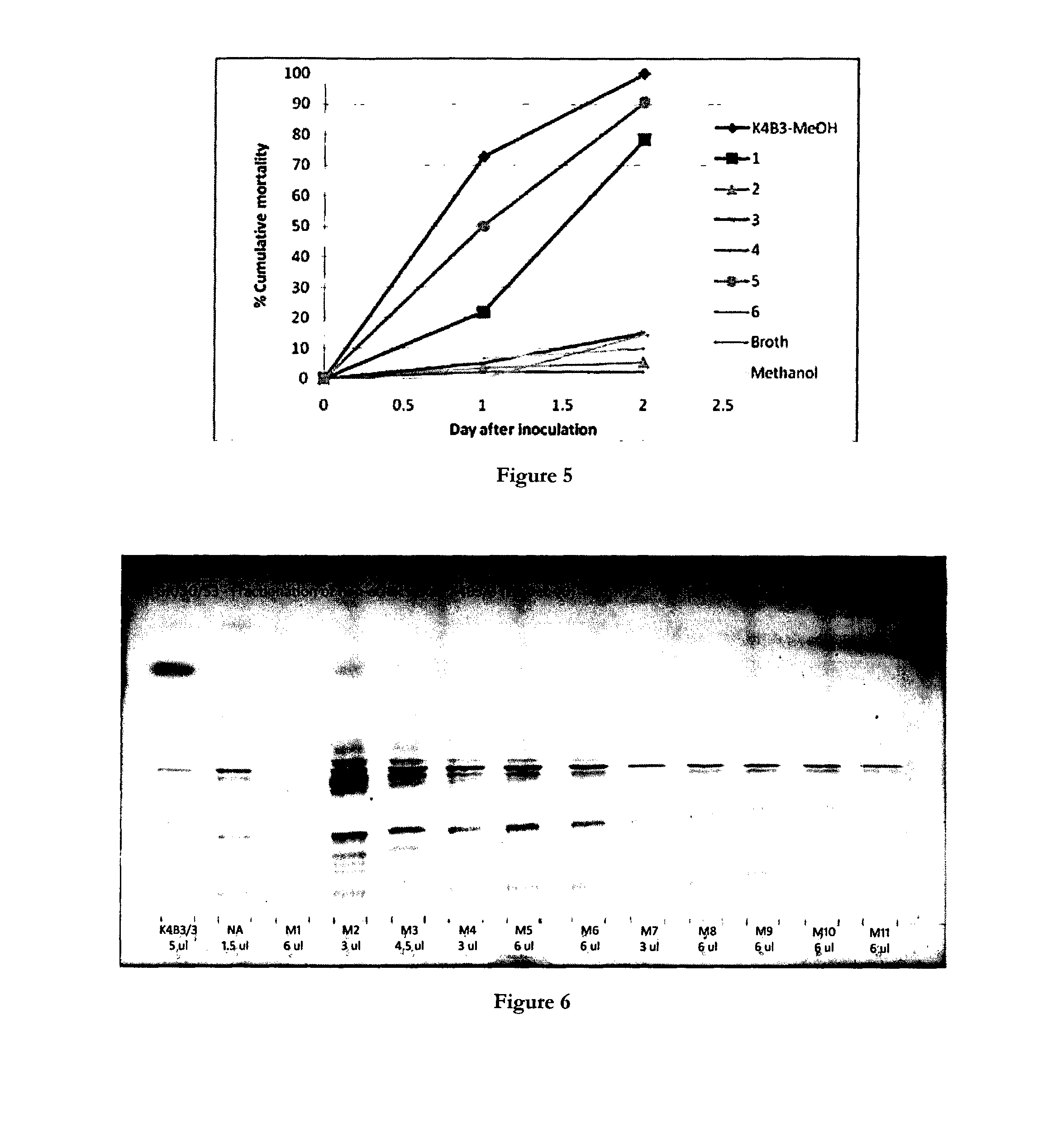Insecticidal Agents and Uses Thereof
a technology of applied in the field of biochemistry, can solve the problems of phytopathogens, plant disease or loss caused by insect pests and pathogens, and significant economic costs for plant-based agriculture and industries, and achieve the effects of reducing the risk of diseas
- Summary
- Abstract
- Description
- Claims
- Application Information
AI Technical Summary
Benefits of technology
Problems solved by technology
Method used
Image
Examples
example 1
Bioassays of Insect Control
[0358]This example describes the development of a robust bioassay to determine the insecticidal efficacy of various lipids or lipid fractions.
[0359]The target insect assay was developed and assessed using the criteria 1) availability, 2) susceptibility and 3) ease of use.
[0360]The target insect Myzus persicae (green peach aphid, order Hemiptera), reared on cabbage plants in a constant temperature room, was used in all experiments. To inoculate aphids with lipid fraction samples, aphids were transferred to a piece of cabbage leaf on the surface of a 1% water agar plate using 0.05% Tween 80 as a wetting agent between leaf and agar. Aphids of mixed age were used, usually between 30-50 / Petri dish.
[0361]A hand-held Paasche airbrush was modified to take micro volumes and used to atomise 300 μl of test or control solutions. Subsequently, plates with treated aphids were maintained at 20° C., 12 h light:12 h dark and checked daily. Dead were removed. Counts of aphi...
example 2
Identification of Insecticidal Lipids
[0362]This example describes the identification and preparation of a range of insecticidal lipid fractions from Beauvaria bassiana K4B3.
Methods
Sample
[0363]Organic solvent-extracted K4B3 mycelia samples were supplied and used for these studies.
Analytical TLC
[0364]Analytical TLC was performed on Merck high performance thin layer chromatography (HPTLC) plates developed using the solvent systems described by Macala et al. (1983). Plates were visualised by dipping in copper sulphate—phosphoric acid and heating at 170° for 15-30 min.
SAX Acidic / Non Acidic Fractionation
[0365]Waters AccellPlus QMA solid phase extraction cartridges were used for anion exchange separation of acidic lipids from non-acidics. Cartridges were first conditioned with chloroform-methanol-0.8M sodium acetate (30:60:8) and then washed with chloroform-methanol-water (30:60:8). Samples were loaded in the latter solvent mixture, which was also used to elute the non-retained (non-acidic...
example 3
Bioassays of Insect Control
[0390]This example describes the development of an expanded range of bioassays to determine the insecticidal efficacy of various lipids or lipid fractions.
[0391]Several target insect assays are developed and assessed using the criteria 1) availability, 2) susceptibility and 3) ease of use. Four insect systems are tested: whiteflies, diamond back moth, mealworm, and mosquito.
1. Whiteflies Nymphs (Hemiptera)
[0392]Whitefly is a major target species, currently lacking suitable control agents. Whitefly nymphs were obtained from Bioforce Ltd (Auckland, New Zealand). Samples of K4B3 lipid fractions and control broth are used to inoculate groups of approximately 100 nymphs through a Potter Tower.
2. Mealworm (Tenebrio molitor) Larvae (Coleoptera)
[0393]Tenebrio larvae are obtained from biosuppliers. Ten larvae are sprayed with K4B3 lipid sample or water control and monitored for 2 weeks.
3. Diamondback Moth-DBM (Plutella xylostella) Larvae (Lepidoptera)
[0394]Diamondb...
PUM
| Property | Measurement | Unit |
|---|---|---|
| angle | aaaaa | aaaaa |
| humidity | aaaaa | aaaaa |
| temperature | aaaaa | aaaaa |
Abstract
Description
Claims
Application Information
 Login to View More
Login to View More - R&D
- Intellectual Property
- Life Sciences
- Materials
- Tech Scout
- Unparalleled Data Quality
- Higher Quality Content
- 60% Fewer Hallucinations
Browse by: Latest US Patents, China's latest patents, Technical Efficacy Thesaurus, Application Domain, Technology Topic, Popular Technical Reports.
© 2025 PatSnap. All rights reserved.Legal|Privacy policy|Modern Slavery Act Transparency Statement|Sitemap|About US| Contact US: help@patsnap.com



